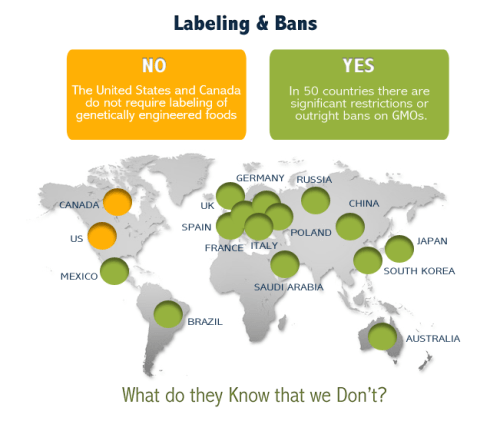The Verdict? Ban GMOs!
In a world where the safety of our food supply is increasingly being called into question, we believe that GMO’s leave too many unanswered questions. Nature, all by itself, knows what’s best. We believe genetically modified foods pose potentially serious risks that the human population should NOT be subjected to without, at the very least, greater knowledge and consent.
Nevertheless, despite the widespread GLOBAL concern, these altered versions of food ingredients continue to be allowed here in the United States and Canada. We believe that if and until GMO’s are banned for good, at the very least, we have a right to know if our foods contain these ingredients!
Example: Genetically Modified corn has been engineered by Monsanto in a laboratory to produce pesticides in its own tissue. GMO Corn is regulated by the Environmental Protection Agency as an Insecticide, but is sold unlabeled.
A GMO is an organism whose genome has been altered by the techniques of genetic engineering so that its DNA contains one or more genes not normally found there. Note: A high percentage of food crops, such as corn and soybeans, are genetically modified.
Currently available GM foods stem mostly from plants, but in the future foods derived from GM microorganisms or GM animals are likely to be introduced on the market. Most existing genetically modified crops have been developed to improve yield, through the introduction of resistance to plant diseases or of increased tolerance of herbicides.
“A genetically engineered food is a plant or meat product that has had its DNA artificially altered in a laboratory by genes from other plants, animals, viruses, or bacteria, in order toproduce foreign compounds in that food. This type of genetic alteration is not found in nature, and is experimental. The correct scientific term is “transgenics,” and is also often referred to as (GE) genetically engineered.”*
Unlike the strict safety evaluations required for the approval of new drugs, the safety of genetically engineered foods for human consumption is not adequately tested. In fact, there have been NO long-term studies conducted on the safety of genetically engireed foods on humans. The fact that over 64countries have banned or require labeling GMO’s should be an eye-opener in itself.
Take Action: Say No to GMOS
Genetically modified foods are ubiquitous in U.S. grocery stores. Here’s how to avoid them:
1. Buy organic.
Foods certified organic by the U.S. Department of Agriculture are guaranteed to be devoid of any genetically modified ingredients.
2. Eat your fruits and veggies.
For the most part, fresh produce like apples, bananas and carrots have avoided the stain of genetic tinkering—for now.
3. Know your food.
Since the U.S. is one of the few countries that still doesn’t label GE ingredients, consumers have to do their own sleuthing for non-GE foods. One great resource is the Center for Food Safety’s guide, which is available as a printable PDF or an iPhone app.



